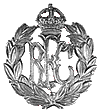
Major Edward C. "Mick" Mannock |

|
By the time Mannock was twelve years old, his Scots father had
abandoned his English wife and children, leaving them destitute. Mannock dropped out of
school to take various jobs in order to help with the family finances. When the war began,
he was interned in Turkey while working as an inspector for a British telephone company.
After an unsuccessful escape attempt, he became deathly ill and was repatriated by the
Turks in 1915. When he recovered, he joined the Royal Army Medical Corps before
transferring to the Royal Engineers. Despite a congenital defect that left him virtually
blind in his left eye, Mannock was accepted by the Royal Flying Corps in 1917, training
under the scrutiny of James McCudden. In April, he was assigned to
40 Squadron where he got off to a slow start with his peers and his Nieuport scout. To the
other flying officers, he seemed aloof and perhaps overly cautious in the air. It was not
until a month later that he scored his first victory by flaming an enemy balloon.
Eventually, Mannock earned the respect and friendship of men like Keith Caldwell. In
February 1918, he was reassigned to 74 Squadron as a flight commander, scoring thirty six
victories with an S.E.5a before replacing William Bishop as the commanding officer of 85 Squadron on 3 July 1918.
Mannock never achieved the public notoriety of Albert
Ball, but he was revered by his men and proved to be one of the greatest flight
leaders of the war. On July 18, 1919 Mannock was awarded the Victoria
Cross. Often physically ill before going on patrol, Mannock routinely shared
victories with other pilots or didn't bother submitting claims for enemy aircraft he'd
downed in combat. After selflessly sharing his 61st victory with Donald Inglis, a newcomer
from New Zealand who had yet to score, Mannock was killed on 26 July 1918 near Lillers,
France when his aircraft was shot down in flames by machine gun fire from the ground.
Inglis was also brought down by ground fire but survived. |
By the end of July 1918, in flying operations over France and Flanders, Major Mannock had been officially accredited with 73 combat victories. In May 1918 he scored no less than 24 victories and on one occasion in July whilst leading an attack on a formation of Fokker aircraft, he shot down one, sent another crashing to earth and was the cause of another pair colliding. The whole of his career in the Royal Air Force was an outstanding example of fearless courage, remarkable skill, devotion to duty and self-sacrifice. |
'Aces' home page | U. S. Fighter | Feedback